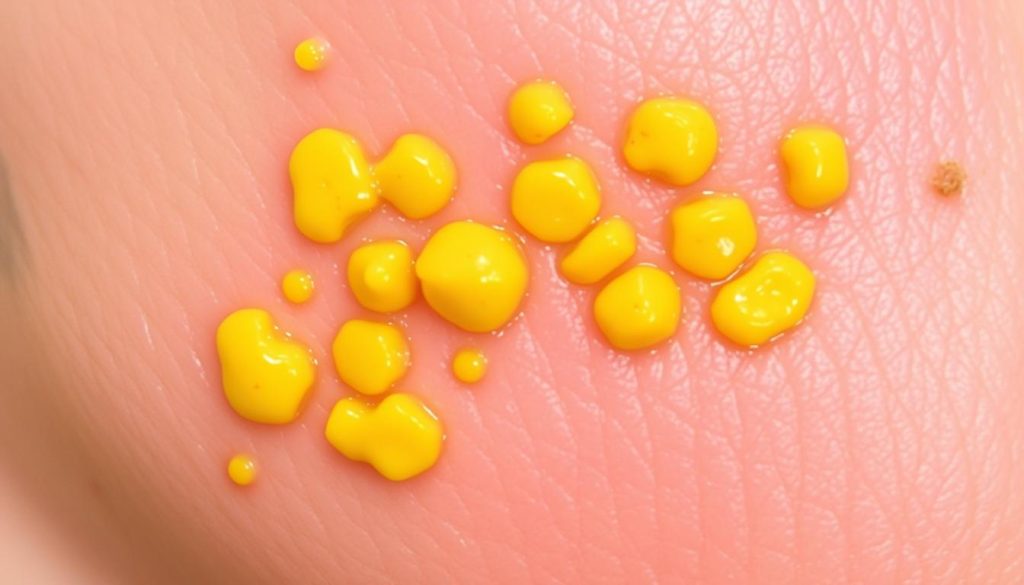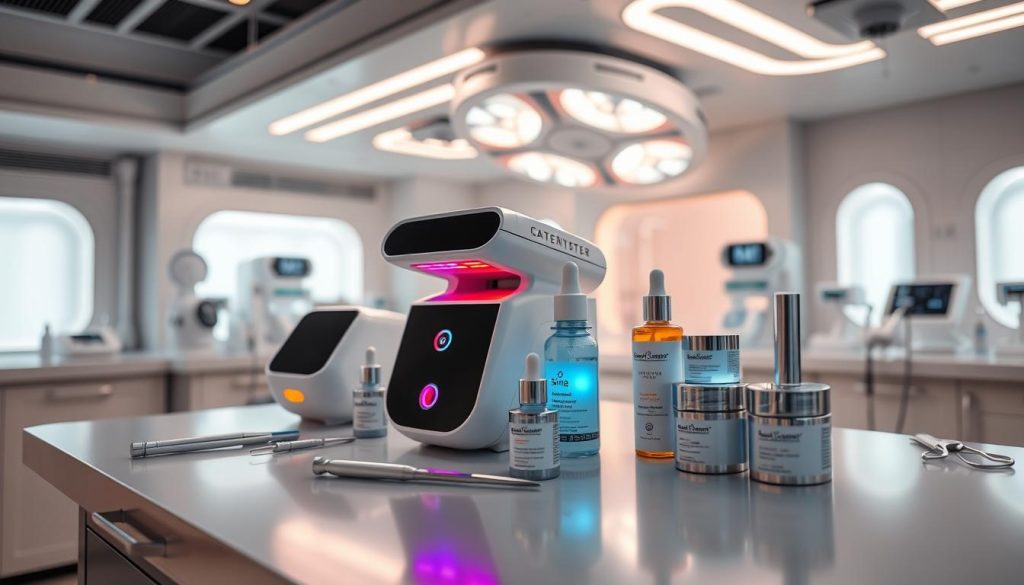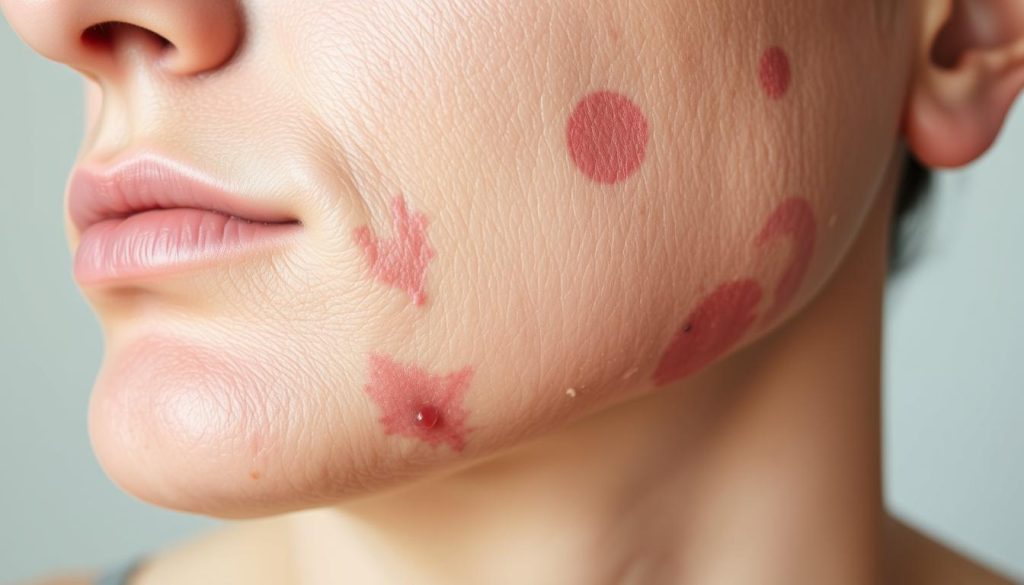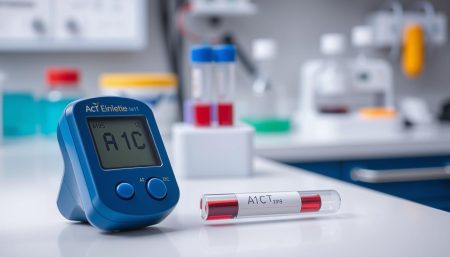Many people worldwide face diabetes mellitus, leading to various diabetes mellitus skin conditions. These skin issues are a big part of dealing with diabetes. It’s important to understand and manage these skin problems well.
These skin concerns can be mild or severe. They show different symptoms that need careful health management.
Skin conditions can greatly affect the lives of people with diabetes. It’s key to look at how diabetes and skin health are connected. We aim to shed light on this relationship, helping those who need it most.
Understanding Diabetes Mellitus and Its Impact on Skin Health
Diabetes mellitus is a long-term condition that affects many parts of the body. Skin health in diabetes is often overlooked, but it’s a common area for diabetic complications. High blood sugar levels can harm blood flow and change how the skin works. This part of the article explains how diabetes leads to skin problems, setting the stage for more detailed discussions.
High blood sugar in diabetes can cause skin issues from dryness to serious infections. This happens because too much glucose damages small blood vessels, cutting off blood flow. With less blood, the skin can’t get the nutrients it needs, making it weak and prone to problems. Knowing how diabetes affects the skin is key to managing and possibly reducing skin health in diabetes.
The list below highlights key diabetic complications affecting the skin:
- Diabetic dermopathy: Often manifesting as light brown, scaly patches often referred to as ‘shin spots’.
- Necrobiosis lipoidica diabeticorum: This rare condition presents as painful, thickened skin patches that may crack and bleed.
- Diabetic blisters: Bullosis diabeticorum can appear on the hands, feet, and forearms, resembling burn blisters but without prior injury.
- Digital sclerosis: The stiffening of the skin typically around the joints, leading to a limited range of motion.
To better understand the wide range and severity of skin-related diabetic complications, a comparative table is provided. It shows the variety and frequency of these skin issues in people with diabetes. This data gives a clear picture of how common and varied skin health challenges are in diabetes mellitus:
| Skin Condition | Frequency in Diabetic Patients | Severity |
|---|---|---|
| Diabetic dermopathy | Common | Mild to Moderate |
| Necrobiosis lipoidica diabeticorum | Rare | Severe |
| Diabetic blisters (Bullosis diabeticorum) | Very Rare | Moderate |
| Digital sclerosis | Less Common | Moderate to Severe |
It’s important to recognize and understand how diabetes mellitus affects skin health. Early detection and treatment can greatly improve life quality and stop skin problems from getting worse in diabetic patients.
Comprehensive Overview of Diabetes Mellitus Skin Conditions
Understanding overview of diabetes skin conditions is key to diabetic skin care. These conditions range from common to rare. They show how diabetes affects the body. We will look at common skin issues in diabetics to spot signs of diabetes on skin early.
Diabetes and skin conditions are closely linked. Skin signs often show up first. Let’s check out some common skin issues linked to diabetes.
- Diabetic Dermopathy: It shows as light brown, scaly patches on the shins. These patches are harmless and usually don’t need treatment.
- Necrobiosis Lipoidica Diabeticorum: This rare condition shows as dull, red patches that turn shiny with a violet border. These patches might itch or become painful.
- Xanthomatosis: It happens when diabetes is not well-controlled. It causes firm, yellow pea-like enlargements in the skin. Each bump is surrounded by a red halo and is sometimes itchy.
- Digital Sclerosis: The skin on the back of both hands becomes thickened and waxy. It tightens and stiffens the joints. This condition mostly affects the fingers.
- Acanthosis Nigricans: It’s recognized by a velvety, dark skin discoloration in skin folds. This condition is linked to insulin resistance.
Proactive diabetic skin care is essential to manage these conditions well. It involves regular doctor visits, keeping blood sugar levels in check, and using special skin care products. Early treatment can greatly reduce symptoms and improve life quality.
| Skin Condition | Description | Common Treatment Approaches |
|---|---|---|
| Diabetic Dermopathy | Scaly patches, often brown, found mainly on the shins. | Usually requires no treatment unless cosmetic concern arises. |
| Necrobiosis Lipoidica Diabeticorum | Red patches that become shiny and painful, on the lower legs. | Steroid creams or injections, assisted by laser therapy if severe. |
| Xanthomatosis | Yellow, pea-like enlargements which can be itchy. | Treatment of lipid abnormalities and better diabetes control. |
| Digital Sclerosis | Thickened skin on the back of hands, causing stiffness in joints. | Control of blood sugar levels can improve symptoms. |
| Acanthosis Nigricans | Velvety, dark discolorations in body folds. | Topical retinoids, vitamin D creams, or laser therapy. |
This overview shows how important it is to recognize and manage diabetic skin care early. Watching for signs and taking care of the skin can prevent these issues from affecting a diabetic’s life.
Diabetic Dermopathy: The Battle with ‘Shin Spots’
Diabetic dermopathy is a common skin issue for millions of people with diabetes. It shows up as light brown, scaly patches on the lower legs. These patches are a sign of the blood vessel changes caused by long-term diabetes.
Identification of Diabetic Dermopathy
The signs of diabetic dermopathy are round or oval patches that start as red or pink. They then turn light brown. These spots are usually painless but might itch or burn for some people.
Understanding the Causes of Diabetic Dermopathy
Diabetic dermopathy happens because of microangiopathy. High blood sugar damages the small blood vessels. This damage stops blood from flowing well, causing the spots on the shin.
Management and Treatment Options
Managing diabetes is key to treating diabetic dermopathy. Keeping blood sugar levels under control helps prevent spots. For spots already there, creams and lotions can help make the skin look better and feel more comfortable.
Below is a table comparing common topical treatments for diabetic dermopathy:
| Treatment Type | Usage | Effectiveness |
|---|---|---|
| Hydrocortisone Cream | Apply twice daily to affected areas | Helps reduce itching and inflammation |
| Moisturizing Lotion | Use daily to maintain skin hydration | Prevents dryness and scaling |
| Anti-fungal Cream | Apply as prescribed if fungal infection is present | Addresses fungal components, improves skin health |
Necrobiosis Lipoidica Diabeticorum: A Deep Dive
Necrobiosis Lipoidica Diabeticorum (NLD) is a long-term skin problem mainly found in people with diabetes. It can also happen in those without diabetes. This condition shows up as yellowish, thick, waxy patches, usually on the shins. Knowing the symptoms, how to diagnose it, and treatment options is key to better care.
Symptoms and Diagnosis
The main signs of necrobiosis lipoidica diabeticorum are hard, raised spots that can grow into bigger patches. These changes make the skin look and feel different. A doctor skilled in skin conditions needs to see these changes to make a correct diagnosis. Sometimes, a skin biopsy is done to confirm the diagnosis and rule out other skin problems.
Paths to Effective Treatment
Treating NLD aims to manage symptoms and slow down the growth of lesions. First, doctors might use topical steroids to reduce swelling. For more serious cases, treatments like phototherapy and systemic medications are considered. Phototherapy uses ultraviolet light to help heal the skin, while corticosteroids or immunosuppressants help with the immune system part of the disorder.
It’s important to keep a close eye on the treatment plan because NLD is a long-term condition. Working closely with both dermatologists and endocrinologists can lead to better management of the condition.
The Onset of Eruptive Xanthomatosis in Diabetics
Eruptive xanthomatosis is a serious skin issue for people with diabetes. It shows up as small, yellowish bumps on the skin. These bumps can itch and are a sign of high cholesterol or triglycerides.
It’s important to manage these symptoms well. This is not just for the skin but also for controlling diabetes.

To manage high blood fats, a good diet and exercise are key. Eating less saturated fat and sugar helps. Sometimes, medication is needed too.
Keeping blood sugar and lipid levels in check is tough. But it’s essential to reduce eruptive xanthomatosis outbreaks.
- Frequent monitoring of triglyceride and cholesterol levels
- Adhering to a diabetes-specific nutritional plan
- Engaging in regular physical activities suited to individual health status
- Using prescribed medications to manage triglyceride and cholesterol levels effectively
Here’s a table showing target levels for blood fats. It’s important for treating eruptive xanthomatosis in diabetics.
| Parameter | Target Level |
|---|---|
| LDL Cholesterol (bad cholesterol) | Less than 100 mg/dL |
| HDL Cholesterol (good cholesterol) | Above 40 mg/dL for men, 50 mg/dL for women |
| Triglycerides | Less than 150 mg/dL |
By aiming for these levels and making lifestyle changes, you can improve your health. This helps your skin look better and your overall health. A careful approach to healthcare is key for managing diabetes skin complications.
Digital Sclerosis: When Diabetes Affects the Hands and Feet
Digital sclerosis, also known as diabetes hand syndrome, is a sign of diabetes. It makes the skin on hands and feet stiff and thick. It’s important to spot early signs and keep joints flexible to manage it well.
To stop digital sclerosis from getting worse, controlling blood sugar is key. Simple daily activities like stretching and physical therapy can help a lot. They keep motion and function in the hands and feet.
Physical treatments are just as important as medicine. Here are some ways to improve joint flexibility in those with diabetes hand syndrome:
- Regular, gentle stretching exercises for the hands and feet.
- Motion exercises to maintain joint function.
- Frequent monitoring of blood glucose levels to maintain them within recommended ranges.
Therapeutic strategies include:
| Strategy | Purpose | Frequency |
|---|---|---|
| Gentle stretching | Prevent stiffness | Daily |
| Strengthening exercises | Improve muscle support around joints | 3 times a week |
| Consultation with a physical therapist | Tailored exercise plan | As needed |
Sticking to these strategies can help manage digital sclerosis symptoms. It improves the well-being and daily life of those affected. By actively managing diabetes, people can keep their hands and feet mobile. This greatly enhances their quality of life.
Acanthosis Nigricans: Addressing Skin Darkening in Diabetes
Acanthosis nigricans is a common skin issue in people with diabetes. It shows up as dark, velvety patches in body folds. It’s often a sign of insulin resistance, which is a big deal for those with diabetes. Knowing what causes it and how to manage it is key.
Causes and Symptoms of Acanthosis Nigricans
Acanthosis nigricans often comes with obesity and insulin resistance, common in type 2 diabetes. These issues make insulin levels go up, causing skin cells to grow too much. This makes the skin darker and thicker. You’ll usually see these dark patches in the armpits, groin, and neck.
Strategies for Managing Acanthosis Nigricans in Diabetics
Controlling insulin resistance is key to treating acanthosis nigricans. Making lifestyle changes can help a lot. This includes exercising regularly, eating well, and keeping a healthy weight. You might also need to try topical treatments like retinoids, vitamin D creams, or laser therapy to lighten the skin.
| Management Strategy | Benefits |
|---|---|
| Dietary Changes | Improves insulin sensitivity, reduces skin darkening |
| Physical Activity | Enhances metabolic rate, aids in weight loss |
| Medical Treatments | Directly targets darkened skin patches, improves appearance |
Keeping blood sugar levels in check and managing insulin resistance are very important. They help tackle both the cause and symptoms of acanthosis nigricans. Seeing your healthcare provider regularly is a must. They can help you come up with a treatment plan that works best for you.
Exploring Scleredema Adultorum of Buschke in Diabetic Patients
Scleredema adultorum of Buschke is a long-term condition that makes skin thick and hard. It mainly affects people with diabetes. This diabetes-related skin thickening not only changes how a person looks but also affects their life quality.
The skin becomes hard, like wood or stiff. It usually starts in the neck, shoulders, and upper back. But it can spread to other parts of the body.
Diabetes and this skin condition are closely linked. Managing diabetes well is key. Early detection and managing skin hardness can stop the condition from getting worse. Keeping blood sugar levels stable helps control the skin symptoms.
Dealing with scleredema adultorum of Buschke needs a team effort. Physical therapy helps keep the skin flexible and prevents stiffness. Medications that make the skin more elastic and thinner are also helpful. Knowing about the disease and its treatments can improve patient results.
- Regular monitoring of blood glucose levels to manage diabetes effectively.
- Physical therapy sessions to enhance skin mobility.
- Use of pharmacological treatments to reduce skin thickness and improve elasticity.
Even though scleredema adultorum of Buschke is tough, new treatments and understanding the diabetes-related skin thickening have helped a lot. For those with diabetes, regular health checks and a complete care plan are essential. They help manage diabetes and skin problems well.
The Rare Occurrence of Bullosis Diabeticorum
Bullosis diabeticorum, also known as diabetic blisters, is a rare but important skin issue linked to diabetes. It shows up as painless blisters filled with fluid. It mainly affects people with long-standing diabetes or those with blood sugar that often changes.
This condition is not common but needs the right care and knowledge for management. It’s vital to handle the skin of people with diabetes very carefully to prevent making things worse.
Recognizing the Signs of Bullosis Diabeticorum
Diabetic blisters can look scary because they show up without any injury. They usually pop up on the feet and hands. They can be different sizes and look like burn blisters. But, they don’t hurt or get red, which helps tell them apart from other diabetes-related skin issues.
Treatment and Care for Sufferers
Dealing with bullosis diabeticorum starts with keeping blood sugar levels in check. High blood sugar can make blisters worse. So, keeping an eye on and controlling blood sugar is key to stop new blisters and help old ones heal.
It’s also important to be very gentle with the skin of people with diabetes. They should not pop the blisters to avoid infections. Usually, diabetic blisters heal on their own if diabetes is well-managed. It’s a good idea to see a doctor regularly to watch for any skin changes and get them treated right away.
Diabetes Mellitus Skin Conditions: From Symptoms to Solutions
Understanding diabetes skin symptoms is key. It helps manage and treat various skin issues. These can range from dry, itchy skin to serious problems like ulcers or infections.
To manage diabetes skin symptoms, keeping blood sugar levels stable is important. This helps prevent and treat skin problems. Here are common symptoms and skin condition solutions.
- Extremely dry skin – Use moisturizers for sensitive skin to avoid cracking and peeling.
- Yellow, reddish, or brown patches of skin – These might be signs of necrobiosis lipoidica. See a doctor right away.
- Hard, thickening skin – Digital sclerosis can be lessened by keeping blood sugar in check.
A comprehensive diabetic skin care routine is vital. It includes gentle cleansing and avoiding hot showers. Also, use humidifiers in dry places to keep skin moist. Regular doctor visits help catch and manage skin issues early.
Knowing about diabetes skin symptoms and taking good care can help manage most skin problems. This way, people can live comfortably without the pain of untreated diabetic skin issues.
Coexisting Syndrome: Diabetes and its Acanthosis Comorbidity
Managing diabetes is complex, and knowing about coexisting syndrome is key. This is true when diabetes meets conditions like acanthosis comorbidity. For diabetic patients, this mix can make treatment harder. So, a combined approach is needed to tackle both problems at once.
Defining Coexisting Syndrome
Acanthosis nigricans often shows up in people with obesity-related diabetes. This condition means diabetes and skin problems happening together. It can really lower a patient’s quality of life. Spotting this issue is the first step to better care.
Integrated Treatment Approaches
Healthcare experts push for a single plan to handle this syndrome. It’s not just about controlling blood sugar. It also includes treatments for skin issues linked to acanthosis comorbidity.
Table: Overview of Integrated Diabetes Management Strategies
| Management Aspect | Approach | Benefit |
|---|---|---|
| Glycemic Control | Medication, Diet, Exercise | Stabilizes blood sugar levels |
| Dermatological Care | Topical treatments, Dermatological consultations | Reduces skin darkening and discomfort |
| Lifestyle Modifications | Weight management, Nutritional counseling | Addresses underlying obesity, reduces skin symptoms |
With the right treatment, people with diabetes can manage their symptoms better. This leads to a better life and health for them.
Preventing and Treating Skin Infections in Diabetics
People with diabetes face a higher risk of skin infections. This is because their immune system is weaker and their skin barrier is less effective. It’s key to know how to prevent diabetic skin infections and treat diabetes-related infections. This helps keep their health in check.
Good hygiene and watching the skin for signs of infection are important. Here are some key steps for preventing and treating infections:
- Maintaining Skin Integrity: Check the skin for cuts, blisters, and dry spots often. This helps catch and treat problems early.
- Hydration: Keeping the skin moist stops it from cracking and peeling. This makes it harder for infections to start.
For treating diabetes-related infections, acting fast is key:
- See a doctor right away if you notice any infection signs.
- Take antibiotics as your doctor says to fight the infection.
- Follow the doctor’s wound care advice to help it heal and avoid more problems.
Understanding the Psychological Impact of Skin Conditions in Diabetes
The psychological effects of diabetes are deep, even more so with visible skin issues. These problems can cause a lot of emotional pain. They affect a person’s mental health and overall happiness.
It’s key to keep mental health in check with diabetes. Chronic skin problems often make people feel bad about themselves. They can also make it hard to connect with others.
- Regular consultations with healthcare providers.
- Engagement in supportive therapy or counseling.
- Connecting with community support groups.
These actions help with coping with skin conditions and managing diabetes. They also help with the mental side of things. It’s important to treat the physical symptoms and help with the emotional side too.
Knowing how mental health and diabetes connect can help patients get the right support. This ensures a complete approach to staying healthy, even with diabetes and skin problems.
Skin Care: Tips for Diabetics to Maintain Healthy Skin
Good skin care is key for diabetics to avoid serious skin issues. It’s important to mix good skin care tips with a daily routine. This helps keep the skin healthy and stops problems before they start.
Daily Skin Care Regimen for Diabetic Skin
Start your day with gentle, hydrating steps. Use lukewarm water and a mild soap without alcohol or fragrances. These can hurt diabetic skin. Keeping the skin moist is also key; apply moisturizer when it’s damp.
This daily routine helps keep the skin’s barriers strong. It lowers the risk of infections by preventing skin breaks.
Preventive Measures to Safeguard Against Skin Complications
Preventing skin issues starts with regular skin checks. Look for cuts, bruises, or changes in your skin, and pay extra attention to your extremities. Poor circulation can slow healing.
Also, see a dermatologist once a year. They can catch and treat any skin problems early.
| Daily Routine | Benefit |
|---|---|
| Gentle Cleansing | Prevents skin irritation and dryness |
| Hydrating Moisturizers | Enhances skin barrier function |
| Regular Inspections | Early detection of skin abnormalities |
By following these tips and being careful with your skin, you can greatly reduce risks. This makes it easier to keep your skin healthy and strong. With regular care, you can prevent many skin problems and live a healthier life.
Advancements in Medical Treatments for Diabetic Skin Conditions
The field of medical advancements in diabetes care has grown a lot. This growth is mainly in innovative diabetic skin treatments. New discoveries have changed how doctors treat skin problems linked to diabetes.

New medicines are being made to target the root causes of skin issues in diabetics. The latest diabetes research has led to new creams and ointments. These not only treat symptoms but also help fix the skin’s barrier, stopping more damage.
- New biologic drugs aimed at reducing skin inflammation specific to diabetic patients.
- Advanced moisturizing solutions incorporating glycemic control properties to minimize dryness and cracking.
- Breakthroughs in light therapy to improve healing of diabetic ulcers, significantly reducing the risk of infection and amputation.
Surgeries have also improved, with less invasive methods. These new surgeries help patients heal faster and have fewer problems. They are made to deal with the special challenges of diabetic skin issues.
| Treatment Type | Description | Benefits |
|---|---|---|
| Topical Agents | New formulations designed to enhance skin hydration and repair. | Reduces episodes of skin breakdown and enhances quality of life. |
| Surgical Advances | Minimally invasive surgeries for removing necrotic tissue. | Faster healing, reduced risk of severe infections. |
| Biologic Therapies | Drugs targeting specific inflammatory pathways in diabetic patients. | Targeted treatment, fewer systemic side effects. |
This new era of innovative diabetic skin treatments offers better care options. It gives hope to those dealing with diabetes-related skin problems. More research and new solutions are leading to better treatments and better lives for patients.
The Role of Nutrition in Managing Diabetes Skin Issues
Nutrition plays a big role in managing diabetes, not just in controlling blood sugar. It also affects skin health. People with diabetes often face skin problems. Eating the right foods can help prevent and manage these issues.
A diet rich in low-glycemic foods is key. These foods don’t raise blood sugar levels quickly. Foods like leafy greens, whole grains, and lean proteins help keep blood sugar stable. This is good for skin health.
Drinking enough water is also important. It keeps the skin moist and elastic. People with diabetes often struggle with this. Drinking water and eating water-rich fruits and veggies helps.
Getting the right vitamins and minerals is also vital. Nutrients like vitamin C, zinc, and omega-3 fatty acids are good for the skin. They help with collagen production and reduce inflammation. This supports the skin’s natural barrier and healing.
In short, a balanced diet is key for skin health in diabetes management. It helps improve skin resilience and appearance. Keeping the skin healthy prevents and helps treat skin problems. So, it’s important to pay attention to what we eat and how it affects our skin.
FAQ
Q: What are the common skin conditions associated with diabetes mellitus?
A: Diabetics often face skin issues like diabetic dermopathy and necrobiosis lipoidica diabeticorum. They may also experience eruptive xanthomatosis, digital sclerosis, and acanthosis nigricans. Scleredema adultorum of Buschke and bullosis diabeticorum are other conditions they might encounter.
Q: How does diabetes mellitus impact skin health?
A: Diabetes can harm skin health by narrowing blood vessels. This reduces blood flow, causing dryness, itching, and infections. It also leads to poor wound healing and changes in skin color.
Q: What are the signs of diabetes on the skin?
A: Diabetic skin signs include yellow, reddish, or brown patches and hardening skin. Blisters or sores and shin spots known as diabetic dermopathy are common. Dark, velvety patches called acanthosis nigricans are also a sign.
Q: How can diabetic skin conditions be managed and treated?
A: Managing diabetic skin conditions starts with controlling blood sugar. Topical treatments and lifestyle changes are also key. Some conditions may need medication, laser therapy, or other treatments.
Q: What can trigger bullosis diabeticorum in diabetics?
A: The causes of bullosis diabeticorum are not fully understood. It often affects those with long-standing diabetes and neuropathy. Poor blood sugar control may also play a role.
Q: What are some preventive measures for skin complications in diabetics?
A: Preventive steps include controlling blood sugar and moisturizing the skin. Daily skin checks and wearing proper footwear are also important. Regular health check-ups are essential.
Q: Why is nutrition important in managing diabetes skin issues?
A: A balanced diet is key to managing diabetes and preventing skin problems. It helps control blood sugar and supports skin health. Foods low in glycemic index, rich in omega-3s and antioxidants, are beneficial.
Q: How can psychological support help diabetics with skin conditions?
A: Psychological support is vital for diabetics with skin issues. It helps them deal with emotional stress and boosts self-esteem. Counseling, support groups, and stress management can improve mental health.


















